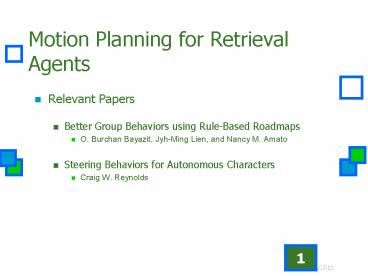Motion Planning for Retrieval Agents - PowerPoint PPT Presentation
1 / 22
Title:
Motion Planning for Retrieval Agents
Description:
Motion Planning for Retrieval Agents Relevant Papers Better Group Behaviors using Rule-Based Roadmaps O. Burchan Bayazit, Jyh-Ming Lien, and Nancy M. Amato – PowerPoint PPT presentation
Number of Views:85
Avg rating:3.0/5.0
Title: Motion Planning for Retrieval Agents
1
Motion Planning for Retrieval Agents
- Relevant Papers
- Better Group Behaviors using Rule-Based Roadmaps
- O. Burchan Bayazit, Jyh-Ming Lien, and Nancy M.
Amato - Steering Behaviors for Autonomous Characters
- Craig W. Reynolds
2
Motion Planning for Agents
- Objective Given a known workspace and a
pre-computed roadmap that covers the space - Visit every node and edge at least once
- Retrieve all scattered particles
3
Assumptions
- Agents have no prior knowledge of particle
locations - Agents have omni-directional line of sight vision
capabilities (not constrained by distance or
angle) - There is no direct communication between agents
but they communicate indirectly by encoding
information in the roadmap - Global information
- Node Positions
- Geometry and location of obstacles
4
Roadmap
- Roadmap contains a set of nodes from which entire
polygonal workspace is visible - Nodes represent feasible agent configurations
- Edges represent feasible sub-paths
- Roadmap is adaptive edge weights are updated by
agents
5
Agent Strategies
- Exploring
- Objective is to traverse the roadmap until it
finds a particle - Homing
- Objective is to carry a discovered particle to a
drop-off location
6
Algorithms
- Exploring Strategy
- Each agent moves independently
- All edges have equal weights to start with
- At each node, an agent chooses an edge to follow
based on the weights of the nodes attached
edges. Similar to ant colony optimization,
guarantees all nodes eventually get visited - The weight of the chosen edge is increased
7
Algorithms
- Exploring Strategy
- AgentVar Node nextNode
- AgentVar Edge edge
- edge node.probMinEdge()
- nextNode edge.end
- agent.goal nextNode.position
- edge.weight edge.weight1
8
Algorithms
- Homing Strategy
- Agent accesses global data to retrieve a path
from its current position to the drop-off location
9
Algorithms
- Homing Strategy
- AgentVar LinkedList path
- AgentVar Node nextNode
- AgentVar Node currentNode
- AgentVar Edge edge
- Path global.getPath(thisPoint, dropOff)
- while(!path.empty())
- nextNode path.getNextNode()
- edge currentNode.getEdge(nextNode)
- agent.goal nextNode.position
10
Velocity-Aligned Local Coordinate Space
- Side Vector
- Forward Vector
11
Agent Physical Model
- Based on a point mass approximation
- Model Properties
- mass scalar
- position vector
- velocity vector
- max_force scalar
- max_speed scalar
- orientation 2 basis vectors
12
Agent Dynamics
- Based on forward Euler integration method
- At each time step behaviorally determined
steering forces (limited by max_force) are
applied to model
13
Agent Dynamics
- steering_force truncate (steering_direction,
max_force) - acceleration steering_force / mass
- velocity truncate (velocity acceleration,
max_speed) - position position velocity
- newForward normalize(velocity)
- newSide.x newForward.y
- newSide.y newForward.x
14
Steering Behaviors
- Seeking (targeting a goal)
- Separation (from other agents)
- Obstacle Avoidance
15
Seeking Steering Behavior
- desired_velocity normalize (target - position)
max_speed - steering desired_velocity - velocity
16
Separation Steering Behavior
- Agents considers agents in its neighborhood
- Neighborhood is characterized by distance
(defines when two agents are nearby) and angle
(defines agents field of view) - Agents outside neighborhood are not considered
17
Separation Steering Behavior
- Compute repulsion force for each agent in
neighborhood - repulsionForce (-1/r)normalize
(neighborPosition position) - Sum up repulsion forces from all neighbors
- steeringForce repulstionForce
18
Separation Steering Behavior
19
Obstacle Avoidance Steering
- Implemented when an obstacle lies in the path of
an agent (range specified by a safe_distance
parameter) - Goal is to maintain an imaginary rectangular free
space in front of the agent - On encountering an obstacle, agent steers to the
nearest visible node that lies in its general
direction
20
Obstacle Avoidance Steering
21
Combining Behaviors
- At each time step, select (in pre-determined
sequence) one steering component to apply - Apply relevant weighting factors, max_force and
max_speed, to each steering component
22
Demo































